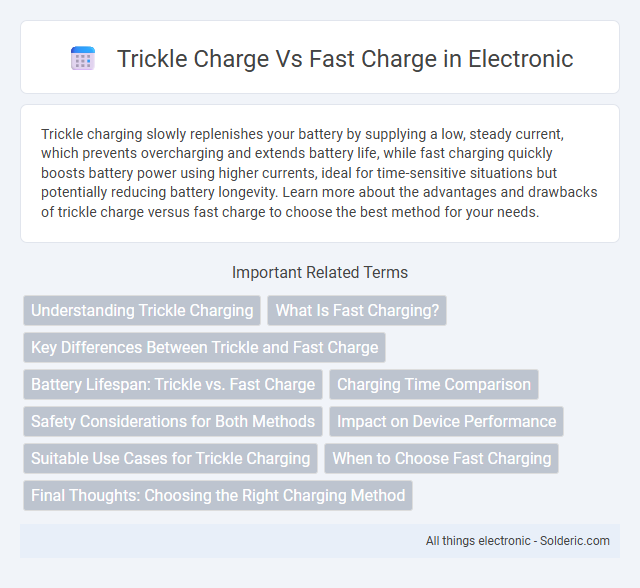Trickle charging slowly replenishes your battery by supplying a low, steady current, which prevents overcharging and extends battery life, while fast charging quickly boosts battery power using higher currents, ideal for time-sensitive situations but potentially reducing battery longevity. Learn more about the advantages and drawbacks of trickle charge versus fast charge to choose the best method for your needs.
Comparison Table
| Feature | Trickle Charge | Fast Charge |
|---|---|---|
| Charging Speed | Slow, typically hours to days | Rapid, typically under an hour |
| Battery Impact | Gentle, prolongs battery life | Higher stress, may reduce battery lifespan |
| Use Case | Maintenance charging, long-term storage | Quick recharge during use |
| Current | Low amperage (few mA to A) | High amperage (several A to tens of A) |
| Application | Lead-acid, NiMH batteries | Lithium-ion, LiPo batteries |
| Safety | Low risk of overheating | Requires thermal management |
| Energy Efficiency | High efficiency due to slow charge | Moderate efficiency, losses due to heat |
Understanding Trickle Charging
Trickle charging maintains a low, steady current to keep a battery fully charged without overcharging, typically around 0.1C (10% of the battery's capacity per hour). It is ideal for long-term battery maintenance in devices such as lead-acid or NiMH batteries, preventing self-discharge and prolonging battery life. Unlike fast charging, which delivers high current to quickly restore capacity, trickle charging prioritizes battery health over charging speed.
What Is Fast Charging?
Fast charging delivers high power to a device's battery, significantly reducing charging time by increasing current or voltage levels compared to standard charging methods. This technology utilizes specialized chargers and compatible devices to safely manage heat and battery health during rapid energy transfer. Fast charging is ideal for users needing quick battery replenishment, especially in smartphones and electric vehicles, where minimizing downtime is crucial.
Key Differences Between Trickle and Fast Charge
Trickle charge supplies a low, steady current to safely maintain battery capacity and prevent overcharging, ideal for long-term battery storage. Fast charge delivers a high current to quickly restore battery capacity, significantly reducing charging time but generating more heat and potential stress on the battery. The primary differences lie in charging speed, current intensity, and impact on battery longevity, with trickle charge favoring preservation and fast charge emphasizing quick replenishment.
Battery Lifespan: Trickle vs. Fast Charge
Trickle charging maintains battery lifespan by delivering a low, steady current that prevents overcharging and reduces heat buildup, which can degrade battery cells over time. Fast charging, while convenient for quick power restoration, generates higher heat levels and stress on the battery, potentially accelerating capacity loss and reducing overall lifespan. To maximize Your battery's durability, favor trickle charging when prolonged use is expected and reserve fast charging for urgent situations.
Charging Time Comparison
Trickle charging typically takes several hours to fully charge a battery, delivering a low current that preserves battery health over time. Fast charging significantly reduces charging time, often achieving an 80% charge in 30 to 60 minutes by supplying a higher current. Battery chemistry and capacity directly influence the exact duration for both trickle and fast charging methods.
Safety Considerations for Both Methods
Trickle charging provides a safer option for battery maintenance by supplying a low, steady current that minimizes heat buildup and reduces the risk of overcharging, preventing potential damage and extending battery life. Fast charging, while significantly reducing charging time, generates more heat and stress on the battery, increasing the likelihood of overheating, capacity loss, and potential safety hazards if not properly managed with advanced battery management systems. Ensuring safety requires selecting chargers with built-in protections such as temperature monitoring, overcharge prevention, and automatic shutoff features for both methods.
Impact on Device Performance
Trickle charge maintains your device's battery by supplying a low, steady current that minimizes heat generation, thereby preserving battery health and extending overall lifespan. Fast charging delivers a higher current to rapidly replenish battery capacity, but can increase internal battery temperature and accelerate chemical wear, potentially reducing long-term performance. Selecting a charging method tailored to your device's usage pattern can optimize battery efficiency and maintain consistent performance over time.
Suitable Use Cases for Trickle Charging
Trickle charging is ideal for maintaining the battery life of vehicles or equipment during extended periods of inactivity, such as seasonal storage or infrequent use. It delivers a low, steady current that prevents battery discharge and sulfation without overcharging. You benefit from this gentle charging method by preserving battery health and ensuring reliable startup performance when needed.
When to Choose Fast Charging
Fast charging is ideal when you need to quickly replenish battery levels, especially for devices like smartphones, electric vehicles, and laptops during short breaks or emergency situations. It provides a higher current flow, enabling up to 80% charge within 30 minutes, significantly reducing downtime compared to trickle charging. Opt for fast charging when time efficiency is critical and the device supports rapid charging protocols such as Qualcomm Quick Charge or USB Power Delivery.
Final Thoughts: Choosing the Right Charging Method
Selecting the right charging method depends on your battery type, usage frequency, and desired lifespan. Trickle charging is ideal for maintaining battery health over extended periods, preventing overcharging and sulfation. Fast charging suits situations where quick power restoration is essential, but frequent use may reduce battery longevity.
Trickle charge vs Fast charge Infographic

 solderic.com
solderic.com